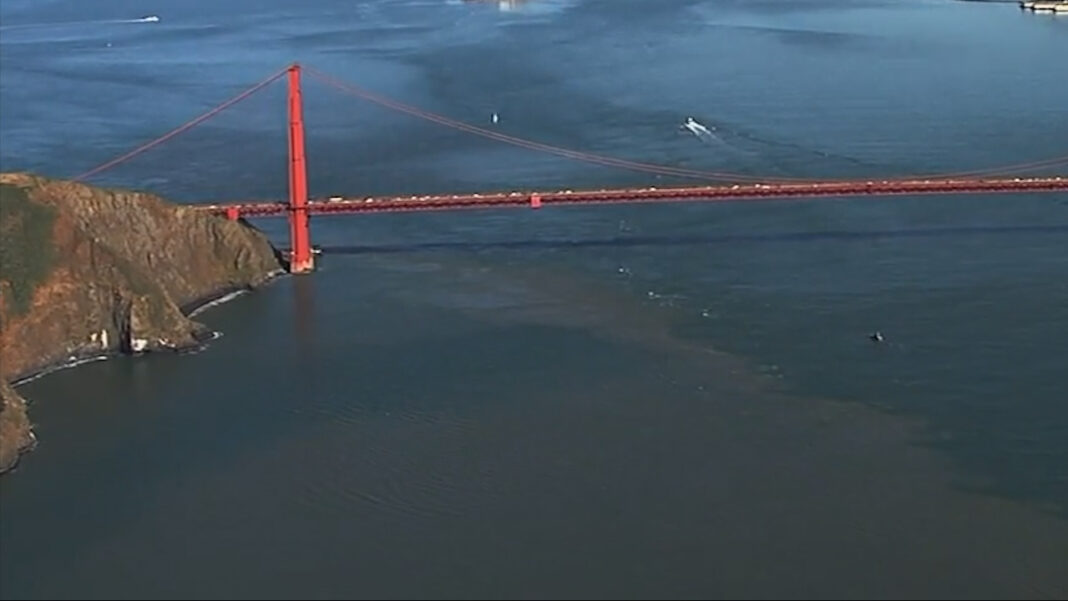SAN FRANCISCO (KGO) — Marine scientist Dr. William Cochlan is old friends with the tiny algae blamed for the recent devastating bloom in San Francisco Bay. He and his colleagues at the Estuary and Ocean Science Center in Tiburon first identified it during an event here nearly two decades ago.
He says the species is both patient and mobile. They’re able to survive in a pod-like state until conditions are right, and actually navigate around the surface to reach sunlight and nutrients. “It has flagella, which are like little tails.
One spins it so like a screw on a ship, and the other one has like a tiller, and it could move around and optimize its position in the water column. So in doing so, it can go right to the surface and get plenty of light, because normally we don’t get big blooms in San Francisco Bay, because of all the silt load and high turbidity,” explains Dr. Cochlan.
But now, changes evolving in San Francisco Bay also have researchers debating what’s ahead and how best to prepare. VIDEO: Harmful algae bloom spreading across San Francisco Bay, turning water brown It’s a complicated equation. For more than a century since the Gold Rush, the Bay has been historically murkier, in part because of the heavy runoff from hydraulic mining.
But for several reasons, many of them good, the Bay water is now generally clearer, allowing sunlight to reach the algae. Add to that, the increased volume of wastewater released from our treatment plants introduce more nutrients like nitrogen into the mix. Senior Scientist Dr.
David Senn studies the relationship at the San Francisco Estuary Institute. “If the light conditions are sufficient for them to actually take off and bloom, if there’s sufficient nitrogen there as well, then they will actually be able to grow until they utilize all of that nitrogen. If there’s less nitrogen there, then there’ll be there’ll be less opportunity for them to grow as big or to spread over a large area or to last as long in the system as they did this time,” says Dr.
Senn. There are proposed strategies — starting with the roughly three dozen wastewater treatment plants that impact the Bay, including adding systems to filter or divert the nitrogen. Eileen White directs the San Francisco Bay Regional Water Quality Control Board.
“So this is a multi-billion dollar issue for the Bay Area. So we want to get it right. And it’s a complicated question, because San Francisco Bay has been a nutrient-rich estuary for many decades.
And we have not seen the problems that we’ve seen until this past month,” White points out. Beyond studying the nutrient issue for more than a decade, she says the agency has asked wastewater operators to take a hard look at their systems. “We asked each of the wastewater utilities to look at potential options for nutrient reduction and look at optimization, what could they do to leverage the existing infrastructure to reduce nutrients, we ask them to look at upgrades to the plant and look at potentially doing site stream treatment,” she explains.
VIDEO: Is it still safe to swim in Bay Area waters amid toxic algae bloom? Experts weigh in And some cost estimates run north of $10 billion. Still, senior scientist Dr. Jon Rosenfield with San Francisco Bay Keeper believes the destructive bloom could actually put an exclamation point on an historic opportunity.
He points to the billions of dollars the state and federal government are preparing to spend on climate and environmental projects. “You know, there is a unique opportunity now where the federal government and state governments have resources and are recognizing the decrepit state of our infrastructure, including our wastewater infrastructure. So, now’s the time to, you know, begin to do those things we know we’re going to have to do anyway,” says Dr.
Rosenfield. In other words, projects with multiple benefits. He says examples could include upgrading wastewater treatment plants to protect them from the threat of sea level rise, while making them cleaner at the same time.
Or expanding efforts to convert treated wastewater into drinking water to fight the drought, which could create an added opportunity to sequester nitrogen in the process. “That’s the hard infrastructure, the human made infrastructure. The other side of this is nature-based infrastructure,” he adds.
Nature-based infrastructure could include restoring the vast tidal marshes that once ringed San Francisco Bay. Again, protecting against the shoreline against sea level rise, while creating a kind of nitrogen sink, where plants can process the damaging nutrients. In the meantime, researchers are still trying to pin down the exact triggers for the recent algae bloom, which may be even more complicated than previously understood.
“So it’s not just a nutrient issue, but decreasing the new nutrient load in San Francisco Bay is the right step for overall healthier Bay,” says Cochlan. If infrastructure projects around the Bay can attract additional state and federal funding, we might think of it as an example of humans learning to play the same long-game the algae do. Moving quickly to take advantage of an opportunity, when conditions are suddenly right.
“Yeah, this is a once in a lifetime opportunity. And the decisions we make now will affect lifetimes to come,” says Rosenfield And there will likely be upgrades coming in any event. Waste Water treatment plants are regulated with what are called Nutrient Watershed Permits.
The renewal process is set in roughly the next two years. If you’re on the ABC7 News app, click here to watch live.
From: abc7
URL: https://abc7news.com/sf-bay-algae-bloom-san-francisco-toxic-wastewater-treatment-keeper/12240632/



